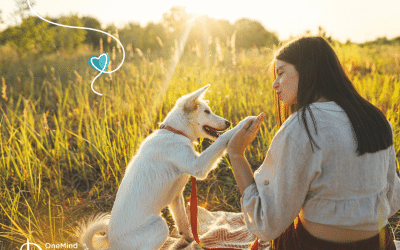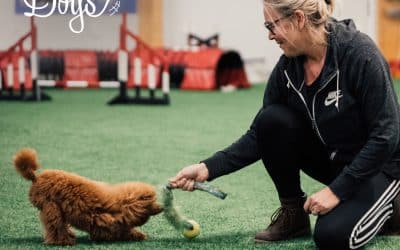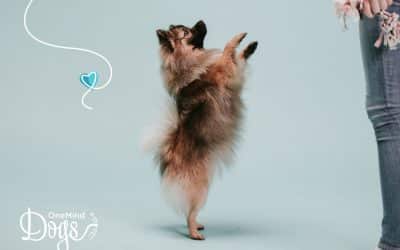Your fur baby is getting a human sibling – how exciting!
Having a baby is wonderful, but bringing your newborn home can be stressful for your dog. They may not be used to sharing your time and attention with someone else, especially such a tiny, noisy human!
There’s a lot you can do to help your dog get ready for the baby long before they arrive. Just like you help kids get used to the idea of sharing their space, the same thing goes for dogs.
In this guide, we’ll cover what to expect from your pup when you’re expecting, and how to handle introductions so you can become one big, happy family. Join OneMind Dogs CEO Noora Keskievari as she talks about introducing your dog to your newborn on The New Mamas Podcast.
Baby basics: How should you prepare your dog for a newborn?
Having a baby in the house is a major life change, one that can trigger stress and anxiety in dogs. If they’re already used to being your “baby,” then they’ll likely exhibit some signs of jealousy and frustration when your attention is elsewhere.
To combat this, we want to start setting healthy boundaries right away.
As soon as you find out you’re expecting, the most important thing is to build a strong relationship with your dog and teach them how to be comfortable alone.
It’s time to begin creating space for your dog. Don’t get us wrong — we love sharing our hearts and homes with our pets. But they need to feel comfortable living independently with us, too.
It’s possible to over-coddle a dog and make it dependent on you for security. When this happens, they can become extremely distraught without your constant love and attention.
When a baby comes home, they may experience major separation anxiety, and they could even start to lash out with possessiveness, guarding, aggression, or destructive behaviors.
Here are some of our top tips for setting boundaries with your dog:
Build a trusting and balanced relationship with the dog
Remember that preventing behavioral challenges is the best way to make sure they never happen. That requires shifting your mindset and transforming your dog’s habits with small details.
Educate yourself on how to properly train and engage your dog’s mind. This will naturally help you develop and enhance your relationship after the baby is born.
A well-behaved dog will know several important cues or commands, like calm down, stay still, and come.
Set a couple of rules, and stick with them (even if there’s no baby coming)
Create their own safe space
All dogs need a part of the house they can go to when they’re stressed. Just have your bedroom, dogs need a place to rest undisturbed. That place can be, for example, a room separated by a baby gate, a fenced area, or a large enough crate. A crate with a cushy bed can be the perfect pup den for your four-legged to feel safe.
If your dog isn’t used to being separated from you, start with small steps. If they aren’t a fan of behind a fence, start small. Leave it open, and praise them whenever they go near it. Give all (or most) of the dog’s meals in that area, and offer treats when they show positive behavior, like sniffing the crate or exploring inside.
It’s critical that the dog learns to calm down by itself. This means that the dog is able to feel calm and settle itself even if you aren’t next to it. Wait for your dog to start learning to rest in its designated area, and start leaving it unattended for short periods of time, like during bathroom breaks, going to the kitchen, etc.
Over time, your dog will start to associate being in their own space with good feelings. Just don’t shut them in a crate until they’ve gotten used to it. They need to spend plenty of time relaxing in it with the door open first. You never want them to feel like they’re being forced into the crate.
Teach the dog to be comfortable without you being next to it. In other words, don’t pay attention to the dog all the time or constantly keep it by your side. Once the baby is born, your attention will be shared. Your dog will need to know how to be comfortable without your constant assurance. This will prevent a lot of stress and unwanted behaviors.
Get them off the bed and sofa
We know, it’s hard to resist those puppy eyes, and your dog may love nothing more than to snuggle up with you on the furniture. Unfortunately, letting your dog spend a lot of time next to you can have some negative consequences.
Teaching the dog not to go on the sofa or bed at all makes it a lot easier for you (and the dog) when the baby arrives. If the dog is already used to spending its time somewhere else, then you don’t have to start the training process while you’re busy with a baby.
If the dog is used to spending time on the sofa or in bed, there is a greater probability of uncertainty, stress, and unwanted behavior. For example. when a newborn is in the house, the dog may be more defensive of its space. You could be feeding the baby on the couch, only to have your dog get territorial.
Establishing a no-furniture rule helps teach your dog that there are boundaries they have to respect. The best way to prevent problems later on, is to teach the dog to sleep somewhere else.
Transform the routines with your dog into an education moment
You are paying a lot of attention to the dog every day. Now, it’s time to transform that time into educational moments where you teach your dog important skills.
Every time you pay attention to the dog, you are teaching it something. Some kind of behavior will be reinforced, so use those moments wisely!
For example, when the dog reacts to its name, you can teach the dog to react quickly. Call the dog, and reward them as soon as they respond.
When going out, teaching the dog to put on its collar by itself is a fun game. At the door, practice patience and staying still. Only let the dog go when you have given the cue word.
Introduce them to the baby’s things
Before your little one arrives, it’s best to incorporate their belongings into your dog’s zone. Let them sniff their blankets and clothes, and get them used to walking with a stroller. You should also use some baby toys to make noises that will become common in your house over the coming months, and teach your dog that these toys are not for them.
Gradual introductions to your baby’s things will make it a lot easier on your dog. The transition won’t feel so abrupt, so they’ll be more likely to feel relaxed and curious rather than threatened when the little one arrives.
Slowly change their schedule to match your baby’s
The newborn hasn’t arrived yet, but that doesn’t mean you can’t prepare your pup for sharing their home! Life with a baby changes everything, including the times you’ll take your dog out, feed them, and play with them.
To make this easier, start getting the dog used to not having clear routines. For example, in the mornings, you may only pay attention to the dog or take it out after you’ve eaten breakfast. This way, the dog learns not to expect certain routines from you and feels more comfortable with ever-changing schedules.
Think about how your schedule will change with the new baby. Part of your dog training can include interacting with your pup at different times. For example, you may be used to taking the dog out around 7 or 8 in the morning. When the baby comes, this could change. You may take them out an hour earlier or later than usual.
Create special moments together
Your dog may not be the center of your attention anymore, but that doesn’t mean they have to feel abandoned. Before the baby comes, help your dog get used to spending certain parts of the day alone without you and some parts doing fun stuff together. The best you can do is to use those moments for brain work, such as teaching your dog to get better with skills like recall and staying still.
For example, you may have an hour or two after dinner to play, train, and snuggle. Even simple acts, like brushing their fur, can be meaningful to them.
Knowing that there is dedicated time for them each day helps curb anxiety and stress. Despite new things happening all around them, your pup will trust that they can count on you to be there.
To keep your dog mentally balanced, avoid a lot of running and chasing games with balls or other dogs. Focus more on brain work, which tires out the dog a lot more while keeping them calmer.
Bringing baby home — The first introduction
It’s always better to be overly cautious than overly confident. Even an over-eager greeting could be dangerous for the baby.
Here’s how we suggest approaching introductions step-by-step:
- Stay calm! Dogs and babies are highly receptive to our emotions. When you’re calm, they’re calm, too.
- You can use a child gate to separate the dog from the living area without making them feel left out. They’ll get to learn new routines, sounds, and smells, all while getting used to seeing the baby.
- Handle introductions with two people — one holding the baby, the other with the dog on a leash.
- Let the dog sniff around the baby, and reward it with plenty of treats. Be sure to remain calm here, speaking in a steady voice. You don’t want to get the dog over excited or think it’s time to play.
- Keep rewarding the dog for acting calmly around the baby. You can do this repeatedly to reinforce the behavior.
- Ask the dog to stay still, and praise them for sitting near you and the baby. It’s okay for them to sniff — you want them to! — but avoid letting them jump or try to climb on top of you.
Remember, you want to reinforce what the dog should do. Correcting it for poor behavior will not teach it what it needs to know.
And what do you do if your dog is overly excited or mouthy? There are a few options. Keep the baby gate up for a while, practicing introductions each day with the leash and treats.
If your dog is mouthy with the baby or their blanket, you can train them to wear a muzzle. The right muzzle does not hurt your dog at all, and still gives them plenty of space to open the mouth and breathe normally.
Getting your dog comfortable with a muzzle is actually a great educational opportunity. It can keep them safer in emergency situations, and it can become a normal part of playtime between a curious baby and excited dog.
Remember, even sweet, playful dogs can accidentally harm a baby.
Growing up with a dog: Safety tips for new parents
As excited as you are for your baby and dog to become BFFs, there are some precautions to take. First and foremost, never leave your baby unattended with your dog, even for a second.
All it takes is a dog jumping onto the couch or grabbing a toy from your baby’s hand for a disaster. And the risk is never worth it, no matter how much you trust your dog.
As your baby gets older, they’ll naturally become more curious about the pup. As their mobility increases, they’ll begin to grab the dog and even try to bite its face or ears. Avoid this at all costs. Teach your baby how to interact with the dog, guiding their hands to gently pet them, and never letting them stick their face in the animal’s.
Never let your child throw things at the dog, and teach them that when the dog is eating or sleeping, no one bothers it. Mutual respect between humans and dogs leads to happy relationships.
And what about puppies?
Puppies are like babies themselves! But you can achieve great results following these steps. Train them a little each day, especially with a good resource like the OneMind Dogs Puppy Training program.
Reward them immensely for calm, good behavior. The goal is to shape their actions into positive ones, not focus on the negative. Over-correction can actually reinforce the behaviors you’re trying to avoid.
And make sure you stay active! Not just with puppies, but every dog. Physical activity is an excellent bonding exercise, but it also helps your dog manage stress and anxiety.
Get a head start on your dog’s training
Before the baby arrives, build a deeper bond with your dog. Now is the perfect time to work any behavioral issues you’re having, like barking, leash pulling, or chewing. Download the OneMind Dogs eBook for free to learn how our perspective makes a difference in dog’s and owners’ lives. For some further exploration on this topic check out The New Mamas Podcast where Noora chats all about introducing your puppy to your newborn.
You can download our app today and get started with puppy training basics — no matter how old your dog really is! These basic manners are good for every dog to learn, and sometimes, a refresher does wonders!



